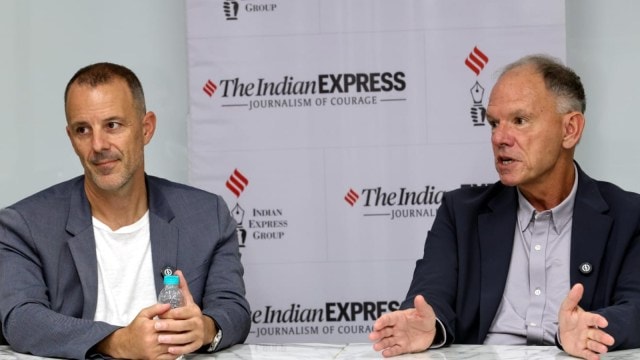‘H-1B move could be a win-win as more talent might return to India’
They said while recent announcements around the H-1B visa may seem worrying at first, but once the details were fully understood, it became far less intimidating. Edited excerpts:
 Geoffrey Garrett (right), Dean of the USC Marshall School of Business and Jared Grusd, Adjunct Prof of Entrepreneurship at the institute, at The Indian Express office in Mumbai.
Geoffrey Garrett (right), Dean of the USC Marshall School of Business and Jared Grusd, Adjunct Prof of Entrepreneurship at the institute, at The Indian Express office in Mumbai.Amid evolving India–US relations, and growing concerns among students reconsidering plans for higher education in the US, Geoffrey Garrett, Dean of the USC Marshall School of Business and Jared Grusd, Adjunct Professor of Entrepreneurship at the institute told The Indian Express that despite the uncertainties, USC has seen a record number of Indian students enrolling across various programmes. They said while recent announcements around the H-1B visa may seem worrying at first, but once the details were fully understood, it became far less intimidating. Edited excerpts:
In recent times, changes to the H-1B visa have become a crucial factor for Indian students considering higher education in the US. How do you view the current regulatory environment around the H-1B visa?
Geoffrey Garrett (GG): One important clarification for students is they do not need the H-1B visa right away. There is a different system called Optional Practical Training (OPT), which allows students to work after graduation. If it’s a STEM (Science, Technology, Engineering, and Mathematics) degree — as all degrees from the Marshall Business School are — students can get up to three years of work experience through OPT.
What we’re really concerned about, from a firm’s perspective, is the increasing hassle of getting an Indian student into the US workforce. That challenge has been growing for a while. However, I suspect that the bigger American companies, where most students aim to work, will absorb the cost. For them, the $100,000 or so is spread over six years, which makes it manageable.
I understand why Indian students are so concerned. But in practical terms, two things matter. First, the job pathways into big firms likely won’t be affected much. Second, several of the major users of H-1B visas were Indian companies operating in the US, so this shift could be a win-win — as more talent might now return to India.
The signal these new regulations send is powerful and concerning. At universities like USC, where international students are our lifeblood, we have to take this seriously. One-third of our entire student body consists of first-generation migrants to the US. But when you unpack the details, the reality is less intimidating than it first appears. We will need to break this down clearly for people — otherwise, it will be a very big change to our business model.
If you can elaborate on this and also did you see any impact on the number of admissions from India this year?
GG: At the business school, we had a record number of Indian students coming in, and I believe that was true across USC, at the UG level as well. We were initially concerned — not just about students from India, but about international students in general — because of visa-related hassles. We feared we might lose a significant number. But that actually didn’t happen. What I think is really happening is that at top-quality institutions, international students have a global outlook, understand the value of the education they are getting. It’s probably the second-tier American universities that will suffer, at least in the short term.
That said, the recent news about H-1B visas is a big deal. From a business model perspective, I am less concerned about the UG programmes, because they are longer — the experience stretches over four years, and you can amortize the uncertainty over time.
The part of our educational system that’s a bit more transactional is the one-year master’s programmes. For those students, this new environment makes the decision much harder: Do I pursue this degree with so much uncertainty around my employment prospects afterward? That’s a real concern, and we’ll need to think carefully about it.
It’s also another reason to seriously consider offering graduate education outside the US — not just as a strategic move, but because it might become a practical necessity.
There’s a growing cultural fear among Indian students they may no longer be as welcomed in the US as before. In your view, what is the one real fear and the one imagined fear they should keep in mind about the American campus?
GG: I have two reactions to that. First, California is demographically different. If you walk down Trousdale Parkway in the middle of the day at USC, you don’t feel like you’re in some mythical version of white America from the 1950s. Southern California is even more cosmopolitan than the Bay Area.
Second, Indian Americans are incredibly influential today—not just as corporate CEOs, but also through the growing power of the Indian caucus in Congress. That should give people a sense of comfort. The success of Indian-Americans is remarkable…
I think the real fear is not uniquely American — it’s global. I never imagined we would see such de-globalization, that the global economy would begin to fracture. I also never expected skilled migration to become such a politically charged issue in so many countries.
The imagined fear, I believe, is around physical safety. The LA riots over the summer were a global news story. People reached out to ask if we were okay. In reality, it was happening in just two blocks of downtown LA. It was the same with the fires in January—tragic, yes—but they were confined to small areas like the Palisades and Altadena. LA wasn’t burning down.
Jared Grusd (JG): At USC, on a day-to-day basis, these fears aren’t what dominate conversations. What students are actually talking about is exactly what you would expect from any time in the past three to five years — learning, developing skills, pursuing interests, and shaping their career trajectories.
In the past decade, more Indian students have been choosing the US for UG education. However, in recent months, growing uncertainty has led many students to consider newer private Indian universities that offer high-quality, flexible education at much affordable rate. How real or significant is this shift, and what should students keep in mind when making their decision?
GG: You are absolutely right about the growing trend of students pursuing UG education abroad — we’ve seen the same shift at USC. This year, international students made up 21% of USC’s incoming UG class overall. At the business school, where I serve as dean, that number was 24%. In fact, the number of Indian undergraduates at USC has doubled over the past five years — and the number of graduate students has increased as well.
Now, however, we are entering a different phase. With India’s New Education Policy (NEP), there is a lot of domestic momentum, particularly with the emergence of high-quality private universities. At the same time, there’s a new opportunity for institutions like ours: foreign universities are now allowed to operate independently in India. That’s a big deal when you start thinking about offshore operations.
My view — especially for USC and our business school — is that we want to continue attracting a global student body, as much as possible.
But we will also need to think globally in a broader sense. Not just about offshore operations, but also about creating career opportunities outside the US. It can’t just be one-way traffic into American jobs.
This marks a significant shift for US higher education at a time when both our reliance on international students and on government research funding is being challenged. And I don’t believe we will return to the old status quo.
On the research side, this means building more partnerships with the private sector, rather than depending primarily on government support. On the education side, it means adopting a more expansive global outlook. We can’t be expecting an endless supply of super-talented students from India coming to LA.
You mentioned the NEP. Does it actually make it easier for foreign universities to set up operations in India?
GG: Yes. And it’s interesting, maybe not surprising, that the two countries that have taken first advantage of that are my home country, Australia, and the UK. I think the reason for that is the financial position of those universities is much weaker than the big, strong American institutions. I suspect the US will be next. It will likely be institutions like NYU and USC, which already have large international footprints and student numbers, including Indians. I do think we’ll just be the leading edge of a change that has to happen, because the underlying model of higher education is being challenged today in unprecedented ways.
There’s a clear supply-demand mismatch in India, and I think that’s something everyone recognises. That’s also where the opportunity lies. It’s why we’re seeing the rise of so many impressive private universities, and why international institutions view India as a compelling market.
Several foreign universities are setting up campuses in India — five in Mumbai alone. But for many students, studying abroad is about gaining international exposure and cultural exchange. Can campuses in India provide that same experience? And will it be a challenge to attract international students to these campuses?
GG: I think the implicit American model for a long time was that everyone in the world wanted, if they could, to get to the US and become as American as possible. That’s clearly outmoded today. So, I think both culturally and economically, we need to go to the world more. Having more balance, rather than this one-way traffic, is the right way to go.
There’s a cultural dimension to that. At the business school at USC, we send a remarkable proportion of our degree students on international experiences. They all want to go to Western Europe because they are familiar with it — they vacation there, they know the culture and history, etc. What I would like to do is proactively get them into leading emerging markets. And India is the obvious place to focus on now.
But the challenges are real. If you haven’t been here, the first impression is often that it’s different, it’s halfway around the world — all of that can feel like a barrier. But I think the opportunity here is so great that if we can grease the wheels by having better access to more things here it will become more feasible.







